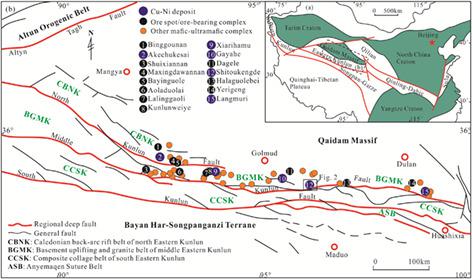The parental magma composition, crustal contamination process, and metallogenesis of the Shitoukengde Ni‐Cu sulfide deposit in the Eastern Kunlun Orogenic Belt, NW China
IF 0.8
4区 地球科学
Q3 GEOLOGY
引用次数: 7
Abstract
Shitoukengde is an important magmatic Ni–Cu sulfide deposit in the Eastern Kunlun Orogenic Belt (EKOB). It comprises several mafic–ultramafic complexes and contains different kinds of mafic–ultramafic rocks. Lherzolite and olivine websterite are the most significant Ni–Cu‐hosted rocks. The No. I complex hosts six Ni–Cu ore bodies, and the depth of the intrusion has great exploration potential. Therefore, geochronology, geochemistry, and mineral chemistry of the Shitoukengde deposit were studied to constrain its mineralization time, parental magma composition, and crustal contamination process. Zircon U–Pb dating of olivine websterite shows the magmatic origin (Th/U = 0.40–1.05) and an age of 418.1 ± 8.7 Ma (MSWD = 0.01), which is coeval with the Xiarihamu, Akechukesai, and other Cu–Ni deposits in the EKOB. Geochemically, the mafic–ultramafic rocks are characterized by low SiO2, TiO2, and Na2O + K2O and high MgO (9.49–36.02%), with Mg# values of 80–87. They are relatively enriched in LREE and LILEs (e.g., K, Rb, and Th), with weakly positive Eu anomalies (δEu = 0.83–2.26), but depleted in HFSEs (e. g., Ta, Nb, Zr, and Ti). Based on the electron microprobe analyses, all of the olivines are chrysolite (Fo = 81–86), and the pyroxenes are dominated by clinoenstatite (En = 80–84) and augite (En = 49–55) in the mafic–ultramafic rocks. Therefore, the composition of parental magma is estimated to be picritic basaltic magma with SiO2 and MgO concentrations of 54.47 and 13.95%, respectively. The zircon εHf(t) values of olivine websterite vary from −0.8 to 4.6, with a TDM1 of 0.84–1.06 Ga, indicating that the parental magma was derived from relatively high degree partial melting (about 13.4%) of a depleted mantle source and experienced significant crustal contamination (about 12–16%). We propose that crustal assimilation, rather than fractional crystallization, played a key role in triggering the sulfide saturation of the Shitoukengde deposit, and the metallogenesis of “deep liquation–pulsing injection” is the key mechanism underlying its formation. The parental magma, before intruding, underwent liquation and partial crystallization at depth, partitioning into barren, ore‐bearing, and ore‐rich magma and ore pulp, and was then injected multiple times, resulting in the formation of the Shitoukengde Ni–Cu deposit.

东昆仑造山带石头坑德镍铜硫化物矿床母岩浆组成、地壳污染过程及成矿作用
石头坑德是东昆仑造山带一个重要的岩浆型镍铜硫化物矿床。它由几个基性-超基性杂岩组成,含有不同种类的基性-超基性岩石。辉橄榄岩和橄榄辉橄榄岩是最重要的含镍铜岩。没有。I杂岩体含镍铜矿体6个,岩体深度有较大的找矿潜力。为此,对石头坑德矿床进行了年代学、地球化学和矿物化学研究,以确定其成矿时间、母岩浆组成和地壳污染过程。锆石U - pb测年结果显示,其岩浆成因(Th/U = 0.40 ~ 1.05),年龄为418.1±8.7 Ma (MSWD = 0.01),与下日哈木、阿克楚克赛等铜镍矿床同时代。镁基-超镁基性岩石具有低SiO2、低TiO2、低Na2O + K2O、高MgO(9.49% ~ 36.02%)的地球化学特征,Mg#值在80 ~ 87之间。它们相对富集轻稀土(LREE)和轻稀土(LILEs)(如K、Rb和Th), Eu呈弱正异常(δEu = 0.83-2.26),而贫氢稀土(如Ta、Nb、Zr和Ti)。电子探针分析表明,基性-超基性岩石中橄榄石均为橄榄石(Fo = 81 ~ 86),辉石以斜长辉石(En = 80 ~ 84)和辉石(En = 49 ~ 55)为主。因此,母岩浆组成为苦橄质玄武岩岩浆,SiO2和MgO浓度分别为54.47%和13.95%。橄榄石websterite的锆石εHf(t)值在−0.8 ~ 4.6之间,TDM1为0.84 ~ 1.06 Ga,表明母岩浆来源于枯竭地幔源较高程度的部分熔融(约13.4%),并经历了明显的地壳污染(约12-16%)。本文认为,石头坑德矿床硫化物饱和的成因主要是地壳同化作用,而非分离结晶作用,“深部液化-脉冲注入”成矿作用是其形成的关键机制。母岩浆侵入前,在深部发生液化和部分结晶,分裂成贫、含矿、富矿的岩浆和矿浆,并多次注入,形成石头坑德镍铜矿床。
本文章由计算机程序翻译,如有差异,请以英文原文为准。
求助全文
约1分钟内获得全文
求助全文
来源期刊

Resource Geology
地学-地质学
CiteScore
2.30
自引率
14.30%
发文量
18
审稿时长
12 months
期刊介绍:
Resource Geology is an international journal focusing on economic geology, geochemistry and environmental geology. Its purpose is to contribute to the promotion of earth sciences related to metallic and non-metallic mineral deposits mainly in Asia, Oceania and the Circum-Pacific region, although other parts of the world are also considered.
Launched in 1998 by the Society for Resource Geology, the journal is published quarterly in English, making it more accessible to the international geological community. The journal publishes high quality papers of interest to those engaged in research and exploration of mineral deposits.
 求助内容:
求助内容: 应助结果提醒方式:
应助结果提醒方式:


